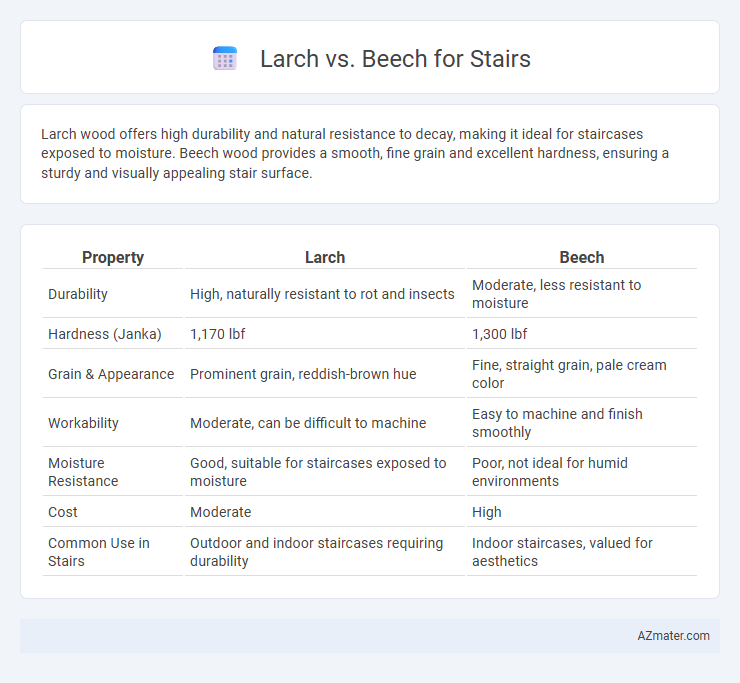Larch wood offers high durability and natural resistance to decay, making it ideal for staircases exposed to moisture. Beech wood provides a smooth, fine grain and excellent hardness, ensuring a sturdy and visually appealing stair surface.
Table of Comparison
| Property | Larch | Beech |
|---|---|---|
| Durability | High, naturally resistant to rot and insects | Moderate, less resistant to moisture |
| Hardness (Janka) | 1,170 lbf | 1,300 lbf |
| Grain & Appearance | Prominent grain, reddish-brown hue | Fine, straight grain, pale cream color |
| Workability | Moderate, can be difficult to machine | Easy to machine and finish smoothly |
| Moisture Resistance | Good, suitable for staircases exposed to moisture | Poor, not ideal for humid environments |
| Cost | Moderate | High |
| Common Use in Stairs | Outdoor and indoor staircases requiring durability | Indoor staircases, valued for aesthetics |
Introduction to Larch and Beech for Staircases
Larch wood offers exceptional durability and natural resistance to decay, making it ideal for staircases subject to heavy foot traffic and moisture exposure. Beech, known for its fine grain and uniform texture, provides a smooth surface and excellent shock resistance, enhancing safety and aesthetic appeal in stair construction. Both larch and beech are favored for their strength and workability, allowing for intricate designs and long-lasting stair systems.
Key Differences Between Larch and Beech Wood
Larch wood is dense, resinous, and highly resistant to moisture, making it ideal for staircases exposed to humidity or potential wear. Beech wood offers a fine, uniform texture with excellent strength and durability, prized for its smooth finish and light color that suits modern interiors. While larch provides natural resistance and rougher grain, beech delivers superior workability and a consistent appearance, influencing the choice based on aesthetic and environmental needs.
Durability: Larch vs. Beech for Stair Use
Larch wood offers superior durability for stair use due to its high resin content and natural resistance to decay, making it ideal for high-traffic areas. Beech, while hard and wear-resistant, is more susceptible to moisture and insect damage, requiring proper sealing and maintenance. Choosing larch ensures longer-lasting stairs with minimal upkeep compared to beech.
Appearance and Grain Comparison
Larch wood showcases a warm, reddish hue with prominent, straight grain patterns that create a rustic, textured appearance ideal for staircases seeking natural charm. Beech features a pale cream to light brown color with a fine, uniform grain that produces a smooth, elegant look suited for modern or traditional stair designs. The contrasting grain complexity and color tone between Larch and Beech allow customization in stair aesthetics based on desired visual impact and interior style.
Workability and Installation
Larch wood offers superior workability for stair construction due to its moderate density and straight grain, allowing easier cutting and shaping compared to the denser, harder Beech. Beech's fine texture and uniform appearance make it ideal for precision joinery but require more effort during installation because of its hardness and tendency to blunt tools. Installation of Larch stairs is generally faster and less labor-intensive, while Beech stairs demand skilled craftsmanship to ensure a smooth, durable finish.
Resistance to Wear and Tear
Larch wood exhibits high resistance to wear and tear due to its dense grain and natural oils, making it a durable choice for stair construction. Beech wood is similarly hard and resilient but tends to be more susceptible to surface dents and scratches over time. For stairs that endure heavy foot traffic, larch provides superior longevity and maintains its structural integrity better than beech.
Maintenance Requirements
Larch wood requires regular sealing and treatment to prevent moisture damage and maintain durability on stairs, while beech demands consistent polishing and protection from humidity to avoid warping and cracking. Both woods benefit from periodic sanding to preserve surface smoothness, but larch's natural resin content provides better resistance to pests compared to beech. In high-traffic stair applications, beech stair maintenance involves careful monitoring for splintering due to its harder grain, whereas larch's softer texture allows easier repair but needs more frequent upkeep to sustain appearance.
Cost Comparison: Larch vs. Beech Stairs
Larch stairs generally cost less than beech stairs due to the abundance and faster growth rate of larch timber, making it a more budget-friendly option for stair construction. Beech, being a hardwood with a denser grain and longer maturity period, commands a higher price but offers superior durability and a finer finish. When comparing costs, larch provides an economical solution without sacrificing structural integrity, whereas beech represents a premium investment for long-term aesthetic appeal and wear resistance.
Environmental Impact and Sustainability
Larch wood boasts a high natural durability and rapid growth rate, making it a sustainable choice for staircase construction with lower environmental impact due to faster carbon sequestration. Beech, while strong and aesthetically pleasing, grows more slowly and requires more intensive forestry management, resulting in a relatively higher environmental footprint. Choosing larch supports eco-friendly practices by promoting renewable timber sources and reducing deforestation pressure compared to slower-growing hardwoods like beech.
Final Recommendation: Choosing Between Larch and Beech
Larch offers exceptional durability and natural resistance to moisture, making it an ideal choice for stairs in high-traffic or humid areas, while beech provides a smooth texture and excellent hardness, ensuring a refined finish and longevity indoors. When selecting between larch and beech for stair construction, consider the specific environmental conditions and desired aesthetic, as larch's rugged grain suits rustic settings and outdoor-like conditions, whereas beech's tight grain and uniform color complement modern, polished interiors. For staircases requiring robustness against wear and tear with a warm, natural look, larch is recommended; for elegant, finely finished stairs prioritizing smoothness and stability, beech is preferable.

Infographic: Larch vs Beech for Stair
 azmater.com
azmater.com